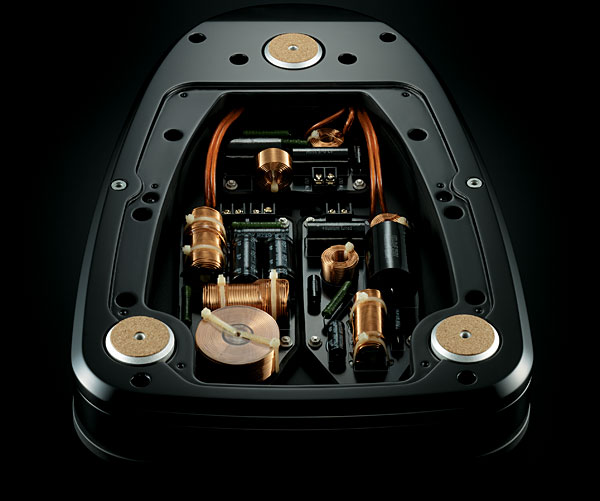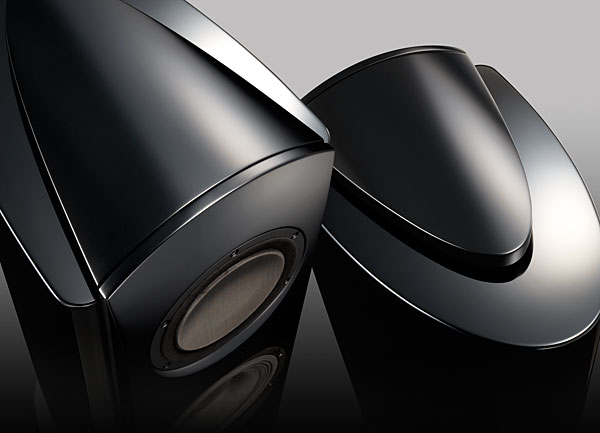| Columns Retired Columns & Blogs |
TAD Evolution One loudspeaker Page 2
Listening
After Jones's departure, I began my casual cohabitation with the Evolution Ones—I prefer to let a speaker begin the conversation before I move on to a more rigorous interrogation. The sound was warm and rich, with extended bass and, at first, a reticent treble, with little airiness. The reticence diminished as I turned up the volume and found myself focusing on the copious detail and depth I was hearing throughout the audioband. The soundstage was seamless and very wide; sounds variously emerged from points just inside, at, or outside the positions of the speakers, as well as from all points between them. Even when I stared directly at one of the TADs, I could never force myself to perceive what I was hearing as coming directly from the speaker. If that isn't an example of a "disappearing" loudspeaker, I don't know what would be.
The TAD-E1's bottom end was very full and tight at all volume levels. Indeed, I could listen at very low levels without the bass ever drying up; the overall sound thus retained a sense of presence and fullness. For example, with "No Sanctuary Here," from Chris Jones's Roadhouses & Automobiles (CD, Stockfisch SFR 357.6027.2), I could not only follow individual voices in the refrain, I could distinguish them spatially, and separately from the bass drone, and at all reasonable volume levels. I evaluated the TAD's low-end extension by listening to the pedalwork of organist Bram Beekman on his Toccata (SACD/CD, Pentatone PTC 5186 003); the speaker's bass wallop by paying particular attention to the timpani and bass drum in Britten's Four Sea Interludes, with Carlos Kalmar and the Oregon Symphony (SACD/CD, Pentatone PTC 5186 471). Both were quite remarkable for a speaker of this size. Heck, for music, I wouldn't have much use for a subwoofer with the Evolution Ones.

The TAD-E1's midrange continued to impress me, particularly with its ability to present convincingly natural reproductions of voices in a recording's acoustical context and perceptually distinct from the speaker positions. I have two favorite reference recordings for testing this. Every audiophile knows the Philips recording of Ariel Ramirez's Misa Criolla, conducted by José Luis Ocejo and with tenor José Carreras, particularly in its XRCD reissue (CD, First Impression LIM K2HD 40). Through the Evolution Ones, I felt that Carreras was not only singing from just right of center and a few feet back, but that his voice had a fullness and presence often heard only with mono-miked or front-and-center voices. My other example is a lovely solo by mezzo-soprano Marianne Beate Kielland: "Come Away, Death," in a 24-bit/176.4kHz PCM recording downloaded from 2L (SACD/CD, 2L-064-SACD). A clean and firm piano (played by Sergei Osadchuk), quite up front, introduces Kielland, whose voice, with a very pure and naked tone, emanated from dead center and a bit above the TADs, and seemed to just float there—a compelling presence.
Big stuff didn't faze the Evolution Ones at all. Played at respectable levels, everything from Pink Floyd's "Another Brick in the Wall," from Burmester's Art for the Ear (CD 2), to Gustav Holst's Planets with Sir Andrew Davis conducting the BBC Philharmonic (Chandos CHSA 5086) had presence, weight, and size, but there was also remarkable inner detail that was not obscured by the ongoing tumult. Only Big speakers—that is, only good big speakers—can do this. What distinguished the TAD-E1 from many other big speakers was that it could successfully scale all of this to lower listening levels without loss of impact, and to even higher levels without loss of clarity. In other words, it didn't "come alive" only at certain volume levels, but satisfied me at any reasonable level suitable to the occasion or my disposition.
Indeed, from top to bottom of the audioband, and from whisper to shout, the Evolution One always sounded balanced. At first I thought it sounded a little dark and closed-in, but that seems to have been a misleading result of its not favoring any particular region of the audioband. A more significant concomitant was that, when present, the TAD's lovely treble and spaciousness emerged naturally. That doesn't mean that the speaker wasn't absolutely brilliant with delectable treble as it delivered violinist Isabelle Faust's sweet, gutsy tones with the requisite amounts of string, air, and space, that space shared with the Orchestra Mozart, led by Claudio Abbado, in Beethoven's Violin Concerto (CD, Harmonia Mundi 902105)—or shared more intimately with Alexander Melnikov's piano in the Violin Sonata 9, Op.47, "Kreutzer" (CD, Harmonia Mundi HMC 901944). And with recordings known for their generous ambience, from the intimate tangos of Será Una Noche (CD, M•A Recordings M052A) to Roberto Gerhard's terrifying The Plague, with Antal Doráti and the National Symphony Orchestra and Chorus (CD, Decca/Explore EXP0005), the Evolution Ones were nothing short of thrilling.

Context
This was true with either of my three-channel power amps: Parasound's Halo A31 or McIntosh's MC303. The latter actually brightened the balance a bit, but overall, I preferred the Halo as being more consistent with the TAD's smooth and self-effacing delivery. With either amp, the Evolution Ones were more open in the treble and produced a wider soundstage than the similarly sized and priced Sony SS-AR1 ($27,000/pair), which I reviewed in the July 2011 issue, though the Sony's bass was even more impressive in size and power. Compared to my resident B&W 800 Diamond speakers ($24,000/pair), which I reviewed in May 2011, the TAD-E1s were a bit more reticent in the treble, and comparable in soundstage width and depth. The B&W's bass, in my room, was as extended as the E1's, but quite a bit less prominent. In general, the differences among the three speakers were immediately audible but not big, and in regard to soundstaging and bass, greatly influenced by my room and setup.
The Bottom Line
The TAD Evolution Ones played everything from audiophile recordings to low-bit-rate Internet radio with aplomb and authority. Teamed up with neutral electronics and a room not excessively damped, they should provide the buyer with richly musical enjoyment for years to come. It's easy for me to say that the Evolution One is a marvelous speaker—I found no fault with it.
- Log in or register to post comments




































